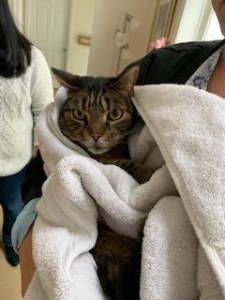There are several diseases and symptoms seen in cats that, for years, have gone medically unexplained. Many, but not all, of the symptoms were grouped into chronic idiopathic lower urinary (LUT) signs, also referred to as “feline interstitial cystitis”(FIC). You may have also heard the term Feline Urologic Syndrome (FUS). Cats may show any combination of straining to urinate, have blood in the urine, have more frequent urinations, and they may urinate in inappropriate places, such as other than in the litter box.
Idiopathic refers to a disease or condition for which the cause is unknown. Nosology refers to the naming of diseases. Pandora syndrome is a term used to refer to these conditions that we don’t yet have a clear underlying cause for, but are temporarily referring to them under this umbrella term until the proper cause or nosological term is identified.
What makes this so challenging is that there are a number of vague, inconsistent, and even intermittently waxing and waning symptoms in these patients. The severity of signs also varies. In addition to urinary signs, we commonly see symptoms of pain, which are not always obvious to the client. Also, some cats also exhibit gastrointestinal tract signs, skin, lung, central nervous system, or cardiovascular signs, hormonal imbalances and challenges to the immune system. Typically, there are multiple symptoms, or “co-morbidities”. Thus, there is a lot of variation in how each individual cat can present. But, what they all have in common is that signs have been shown to resolve with effective environmental enrichment.
Which is huge. And, which is hopeful, because if there is one consistent management resolution, then there may be a common cause or causes, which could help us prevent it. And, that is exactly what seems to be going on. That common thread happens to be stress.
This is not unique to cats. We human beings have also been shown to have Pandora syndrome. We are learning that stress affects many body systems, across species. Reducing stress is a large component of addressing the syndrome. And, of course, treating the specific secondary effects on those body systems.
With feline patients, we are getting better at both identifying sources of stress, and reducing them. External environmental stressors activate the Central Stress Response System (SRS). Suffice it to say that there are countless studies linking SRS activation to specific physiological changes in all these body systems.

Cat environmental stressors:
Cats can be set off by sudden movements, too many other pets or cats in the home, a lack of a quiet environment or place to hide. Loud, or unusual noises, new or unfamiliar places, or homes, or even objects, diverting from their familiar routine can cause stress. The approach of strangers, be they human or other animals walking by the window may all be stressors. Their effects on a cat may result in a lack of predictability or perception that they are not in control of their environment. Depending on how frequent, intense, and how long these issues persist, their psychological well being can be taxed. That may result in them acting out in ways deemed inappropriate, and ultimately make them sick. Some cats seem to have more resilience than others, but cats in general respond adversely to these stressors.

What you might see:
Any combination of lethargy, decreased activity, decreased appetite or drinking, vomiting, diarrhea, fever, decreased interactions or interest in play, and a lack of grooming may be seen. Hiding, and inappropriate urination or defecation are also frequent complaints of pet parents. Many cats will become aggressive towards their human family, or other pets in the home. Because this behavior can wax and wane, and the symptoms may recur, at great cost and distress to the family, it can result in many cats being rehomed, or ultimately euthanized.
What to do:
FUS symptoms should be worked up by your veterinarian to try to distinguish if there is an antibiotic responsive infection present. Pain meds, and antispasmodics are often helpful. The same goes for non-urinary tract symptoms , in that a proper work up is important.
All of us need to step back and evaluate our cats’ environment, and make it as stress free as possible. The layout of your home, where you feed your cat, how you feed your cat, how they play, where they perch, how many litter boxes you have, what type of litter, if you changed the litter…. the list goes on. Important to reassess the layout and think like a cat. If you can reduce stress, sometimes you still need to make some modifications, in diet, supplements, and medications.
Increased water intake seems to be beneficial to cats with FUS. If they simply don’t like canned food, offer various sources of water, fresh options, gurgling fountains if they prefer. Trial and error to find what your cat likes.
Your doctor may recommend a specific diet based on testing of the urine.
They may also find that antidepressants or anti anxiety medications are indicated, either in the short term or long term. Sometimes, as you enrich the environment, you need to do so slowly, and during that readjustment period, these medications may help your cat relearn and readjust.
In the next blog, I will detail specific environmental enrichments that may help your cat.
Please share and subscribe here
Dr. Dawn





